(→Snitches: Small spelling mistake fixed.) Tags: Visual edit apiedit |
Francesco75 (talk | contribs) (→Stalkers: Type of stalkers) Tags: Visual edit apiedit |
||
| Line 269: | Line 269: | ||
Stalkers were gang members trained by the Assassins. They are predominantly found in gang-occupied territories. Similar to the Stalkers in the Ottoman Empire, Stalkers were dressed like normal civilians and can blend in by sitting on benches or even blend in with a group of civilians. However, they are able to hide in hiding spots such as sheds or even bushes, akin to [[Guardian]]s who protected the [[Observatory]]. When they notice Shay, they will attempt to assassinate him by either running towards him or attempt to air assassinate him. |
Stalkers were gang members trained by the Assassins. They are predominantly found in gang-occupied territories. Similar to the Stalkers in the Ottoman Empire, Stalkers were dressed like normal civilians and can blend in by sitting on benches or even blend in with a group of civilians. However, they are able to hide in hiding spots such as sheds or even bushes, akin to [[Guardian]]s who protected the [[Observatory]]. When they notice Shay, they will attempt to assassinate him by either running towards him or attempt to air assassinate him. |
||
| − | Interestingly enough, most Stalkers that Shay encounters are women who wear |
+ | Interestingly enough, most Stalkers that Shay encounters in New York are women, in the River Valley, they are natives american and in North Atlantic, men who wear a similar uniform of spanish captains during the Golden Age of Piracy . |
====Gang Brutes==== |
====Gang Brutes==== |
||
Revision as of 21:39, 6 June 2015
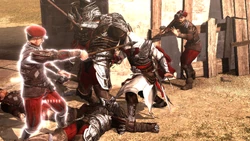
Ezio Auditore fighting several Borgia guards
Guards were members of organized military forces that typically defended or controlled access to locations of interest, or protected certain individuals.
Typically comprised of members of a local militia or governing body's military services, the colors and styles of their uniforms varied, denoting rank, allegiance, and combat specialization.
Factions
High Middle Ages
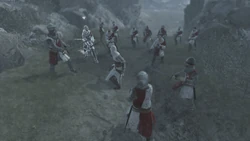
Altaïr Ibn-La'Ahad fighting several Crusaders
During the Third Crusade, soldiers wore the armor and colors of either Saracens or Crusaders, with the latter subdivided into the personal guards of King Richard I of England, or the Knights Templar, Hospitalier, and Teutonic.
Saracens spoke Turkish or Arabic, while Crusaders spoke mostly English, with some Captains and Sergeants speaking French or German. Templar Knights, however, spoke all of the dialects.
Saracens wore lamellar armor, and either spangenhelms or turbans. All Crusaders wore surcoats and chainmail, while some also wore spangenhelms or great helms.
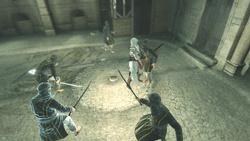
Altaïr fighting Talal's personal guard
The colors of Crusader surcoats differed with their affiliation, with King Richard's personal guard wearing red and white, Templars wearing white with red crosses, Hospitaliers wearing black with white crosses, and Teutonics wearing white with black crosses.
Guards for several smaller factions or individuals possessed their own uniforms as well, such as the black, gold-striped clothes of Talal's men, or the short white robes and gray hoods of the guards of Masyaf.[1]
Renaissance
Throughout the Renaissance, multiple factions of guards existed, as they were affiliated to either individual cities or people instead of armies. They bore unique colors, often along with the family or city crest.
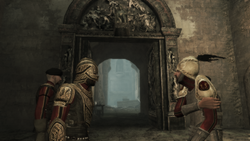
Four Pazzi guards
Guards for the House of Pazzi wore black caps, red sleeves with black and gold streaks, gold armor plates and the crest of the Pazzi. They could only be found in Florence and Tuscany, during the height of the family's influence, until the end of the Pazzi conspiracy.
Guards serving the House of Medici wore dark yellow caps, yellow and white striped sleeves, black armor plates, and the crest of the Medici. They were notably seen during and after the repression of the Pazzi conspiracy in Florence, as well as in San Gimignano.
Guards of the House of Borgia wore dark red caps, black sleeves with dark red streaks, steel gray armor plates and the crest of the Borgia. They often accompanied Rodrigo Borgia, and could also be found around Santa Maria Novella during the Templar meeting, in the Cannaregio District of Venice,[2] or in Florence during the Bonfire of the Vanities. They were also charged with guarding the banks housing the Codex pages.
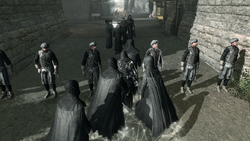
Ezio Auditore da Firenze bypassing a line of Savonarola's guards
Guards of Girolamo Savonarola wore light gray caps, and black sleeves and black or silver armor plates. Instead of a coats of arms, they bore a small portrait of Savonarola himself, with three red beams shining down upon him. They were notably seen in Florence during the Bonfire of the Vanities, often repressing the Borgia guards attempting to take the Apple of Eden.[3]
Guards serving the city of Forlì wore dark green caps and sleeves, as well as the coat of arms of said city.
The guards who served the city of Venice wore blue caps and blue, gold streaked sleeves, with gold armor plates bearing the coat of arms of the Italian city. The quality of their armor was significantly better than that of their counterparts in other cities, protecting them from much damage.
Those who served the Vatican wore white caps, red and white sleeves, with yellow elements on their clothing, and the coat of arms of the city of Rome. Similarly to Venetian guards, their armor was more resilient than most.[2]
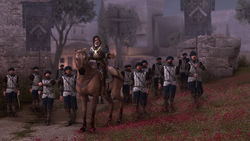
A contingent of French soldiers
Guards and soldiers of France wore dark blue and white, as well as olive green. They were commonly seen in Rome after the alliance of Cesare Borgia and the French general Octavian de Valois.
At that time, French soldiers were stationed in either the main camp in Castra Praetoria, or in military guard posts throughout the Campagna District of Rome. They remained in the city throughout its liberation, often fighting the mercenaries of the Assassin condottiero, Bartolomeo d'Alviano, until the assassination of Valois in August 1503.
Guards from the town of Viana in Spain wore yellowish-green armor. They notably participated in the Siege of Viana, as they defended Viana Castle from King John III's invading Navarrese troops, who wore red uniforms with yellow accents.[4]
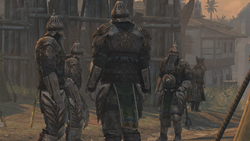
Ottoman Elites in their camp
Constantinople in the Renaissance was divided into two distinct factions, the ruling Ottomans, and the remnants of the ancient Byzantine Empire.
Though Constantinople was held and controlled by the former, guards of the latter constantly fought for control. The region of Cappadocia, particularly Derinkuyu, remained in Byzantine hands.
Ottoman guards wore green uniforms with red accents, though the Janissaries wore more multicolored robes, while Byzantines wore small gray capes, and dark red and brown uniforms, and distinctly wore the black eagle crest of the Byzantine Empire's Palaiologos Dynasty. The Varangians and Almogavars also wore lamellar cuirasses that appeared to be made of gold, or some similar golden metal, with a cross engraved into each lamella in their cuirasses.[5]
18th century Caribbean
During the early 18th century in the Caribbean, there were different factions of soldiers. The first was the British Empire, loyal to King George I, who wore the easily-recognizable red coats shared by the Army and Navy alike, although there were several different styles of the coat. Regulars wore standard-length coats, agile guards wore shorter coats, and grenadiers wore long, heavier variants. Ship captains in the Navy wore dark blue coats with red trim and capes, and bicorn hats that denoted their rank.
The second faction was the Spanish Empire, donning yellow outfits with a red or crimson trim, displaying loyalty to King Philip V of Spain. Their outfits were similar in cut to those of the British Navy, however, Spanish captains wore longer coats in conjunction with an overcoat that covered the upper chest and shoulders, and wore different hats to the British captains.
The Portuguese Navy's sailors dressed in a similar fashion to their Spanish counterparts, although with primarily blue tones and a dark orange trim on their coats, displaying loyalty to King John V of Portugal.
The French soldiers, stationed primarily on Saint-Domingue, wore mostly white coats with blue outlines displaying loyalty to King Louis XV. The slave overseers they colluded with often wore brown or tan outfits.
Another faction working prominently in the Caribbean was comprised of pirate hunters. These self-sustaining soldiers wore clothes based heavily on brown, and pursued pirates who were notorious enough. Pirate hunter ships could be easily identified by their distinct crimson sails and red and black hulls.[6]
Enlightenment Age
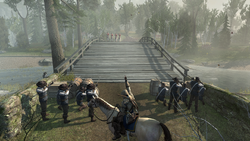
Connor commanding militia in firing lines
During the Seven Years' War, guards were aligned with the British Army who were denoted by their red uniforms or the French Army who were denoted by their white uniforms. Assassin-affiliated gangs were denoted by their orange outfits.
During the American Revolutionary War, guards were aligned with the British Army or Continental Army, or worked as mercenaries. Firearms also became the mainstay of most western armies. All soldiers were armed with flintlock muskets or pistols.
British regulars and militia were easily denoted by their bright red uniforms. The British army also employed Hessian mercenaries such as the Jäger. German soldiers could be distinguished from their British counterparts by their green uniforms with red accents. Patriot soldiers wore mostly blue uniforms, except for Continental Grenadiers, who wore a khaki colored kilt.
In France, guards served the government, or acted on behalf of political extremists to cause trouble. The latter would engage civilians who could fight back. The official guards wore blue, red and white uniforms, with tricorn hats. Their allies, the elite Swiss Guard, often dressed similarly, but were easily distinguishable by their ornate helmets. The extremists frequently wore grey, white, brown, or black clothes, with red elements. [7]
Ranking
High Middle Ages
Regular
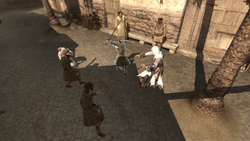
Altaïr fighting regular Saracen guards
Regular guards were the most common, but lightest equipped of the guard ranks. Regular Crusader guards did not have helmets, and only wore padded armor, while Saracen ones wore turbans, and light lamellar armor.
In combat, they were not skilled enough to grab, counterattack, or perform a combo. They could only deflect attacks, with a 25% chance of dodging a light attack.[1]
Sergeant
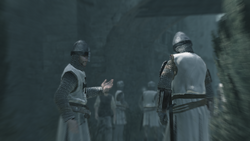
Two Teutonic sergeants talking
Sergeants were middle-ranked soldiers, and were equipped with helmets and heavier armor. Crusaders wore chainmail, and the Saracens possessed medium lamellar armor.
They could grab targets, and had a 50% chance of breaking a grab attack, as well as a 50% chance of countering or dodging a light attack. They also had a 25% chance of breaking defenses, but could not perform combo attacks.[1]
Captain
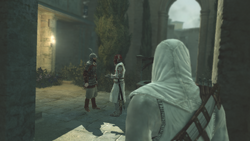
A Saracen captain talking with a Templar
Captains were the most powerful guards, with the exception of Templar Knights. Saracens wore Baidah helmets and heavy lamellar armor, while Crusaders wore chainmail, and varying knight helms.
Guards at this rank were also able to grab, and had a 75% chance of breaking a grab attack, as well as countering or dodging a light attack. They also had a 50% chance of breaking defenses. If a successful heavy attack was delivered, they could perform a combo attack.[1]
Renaissance
Militia
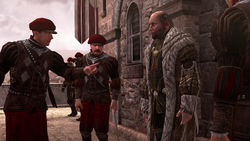
Three Militia guards cornering Egidio Troche
Militia were the lowest ranking guards, and wore very little armor. They also had the lowest morale, and were likely to flee a battle if they were losing.
Militia could be found almost everywhere, and wielded a large variety of medium-ranged weapons. They were not especially agile, but could climb up to the rooftops, albeit slowly, in order to pursue a target Assassin.
Of the guard types, Militia were the only ones who could be fooled into picking up coins, should they be thrown as a distraction.[2]
Elite
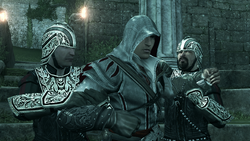
Ezio restrained by two Elites
Elites were stronger than Militia, and wore a moderate amount of armor. They could withstand more damage, and were capable of dodging enemy attacks.
They were also more courageous than Militia, but could still be forced to retreat, especially if their Leader (or a high-ranking specialized guard) should be killed near them.[2]
Leader
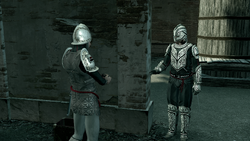
A Leader speaking with an Agile
Leaders were the best fighters, and the most tenacious of all the regular guards. They wore slightly more armor than the Elites, and had distinct, full-faced helmets.
They were resilient, and could withstand several attacks before they could be killed. They were also harder to disarm, as well as resistant to being grabbed.[2]
Captain
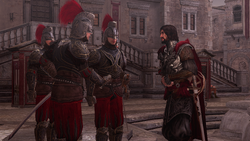
Cesare Borgia speaking with his Captains
Captains of the Renaissance were usually found leading contingents of lower-ranked soldiers. They fought similarly to Leaders, but were more heavily and intricately armored, with full feathered helms.
Twelve Borgia Captains were particularly distinguished members of this rank, and led troops at each of Rome's twelve Borgia Towers. They were armored identically to other Captains, but wore white capes with the Borgia crest.
Though most were courageous and skilled enough to counter most attacks, some were cowardly, and would flee into their tower should it be attacked, until the next guard patrol was posted.[4]
18th century Caribbean
Regulars
Regulars are the basic soldiers seen on the Caribbean. They wear different colored coats, the color of the coat showing off their allegiance. The red coat is worn by soldiers of the Royal Navy, yellow coat is worn by the soldiers of Spanish navy and the blue coat is worn by the soldiers of Portuguese Navy. Pirate Hunters and Smugglers also fall in the same category but they wear brown shirts instead of coats. They are equipped with a basic sword and a pistol. They mainly engage their enemy with their swords but will draw their pistols if the target is out of reach, such as on rooftop. They are seen on many different places of Caribbean but mostly in cities, smuggler caves and onboard ships. They have high discipline standards and will never run away from battle.
Enlightenment Age
Gang members
Regulars
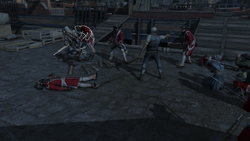
Connor and Stephane Chapeau fighting the Regulars
The basic guards within the British and Continental armies were enlisted soldiers who wore regular battle-dress. They were equipped with muskets that held fixed bayonets and received training in forming firing lines. Regulars were susceptible to counter kills, throws, stuns, disarms and secondary weapon kills.
British Regulars wore a bright red tunic with white leggings and a black tricorn hat, and some took to wearing scarves around their faces. They had the ability to form a firing line quickly and efficiently and didn't run from battle due to the Army's severe discipline standards.
The Continental Army wore a blue battle-dress with a red accent down each lapel and a black tricorn hat. Although they were equally well-trained, they did not have the same discipline as their British counterparts. They would run after a sufficient amount of their comrades fell or when their leader was slain.
Militia
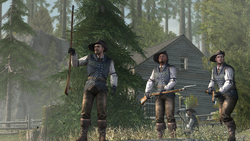
Continental militiamen in Concord
Militia of both the British and Continental armies could be found as guards on rooftops or inside forts, where they were being trained. Loyalist militia wore similar clothing to British Regulars, but instead featured an explorer's cap instead of a tricorn, as well as a backpack and dark spatterdashes. Onboard ships they were dressed as Royal Marines.
Patriot militia wore a white shirt and a blue vest, together with an explorer's cap. Miltia soldiers were not as well-trained as Regulars, as they could only attack once per a Regular's three times, though despite this, they took on almost identical roles.
French Revolution
Militia
The militia were the main bulk of the Revolutionary forces. They were dressed in simple striped red and black attire with tricorne hats. They carried simple sabers and walked the streets causing trouble by harassing civilians. It could be assumed that these types of guards were oblivious to the Templar hand behind the Revolution.
Enforcers
The most common enemy aside from the Militia were the Revolutionary Enforcers, or the blue coated city guard. They behaved similarly to Militia guards but were harder to take down in an open fight. The Revolutionary variants of this guard type wore long, brown leather coats.
Ranged types
As most standard guards only had medium or short-ranged weapons, they were often supplemented by ranged guard types, who could attack from a distance. More types were added over time, with the advancement of weapon technology.[1][2]
Renaissance
Archers
- Main article: Archers
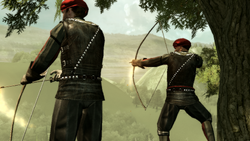
Borgia archers in the Apennine Mountains
Archers were guards armed with longbows, who patrolled rooftops and watched for possible enemies below.[2] Outside of cities, they were posted on elevated watchtowers.[1]
Crusader Archers wore the same uniforms as the standard guards of their faction, though they also had white hoods.[1] In the Renaissance, Archers were usually of the Militia rank, and wore the same uniform as their standard counterparts.
Once provoked due to an enemy approaching within a meter or so, an archer would cease firing arrows, and draw his medium-ranged weapon, such as a sword or mace. Though accurate and deadly from a distance, Archers did not pose a serious threat in close combat.[2]
Crossbowmen
- Main article: Crossbowmen
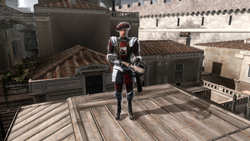
A Borgia crossbowman
Similarly to Archers, Crossbowmen defended the rooftops or areas of interest, though the crossbows they wielded could be fired more quickly, and caused more damage.[4] However, they did not completely replace Archers, as longbows were more accurate if used by a skilled guard.[8]
Unlike Archers, Crossbowmen had no melee weapon, and if their enemy drew too close, they would only back away and keep firing. They were also more vigilant, and possessed some free-running ability, which permitted them to more closely investigate intruders.
In Rome, Crossbowmen could be distinguished by their striped berets and light armor.[4]
Arquebusiers
- Main article: Arquebusiers
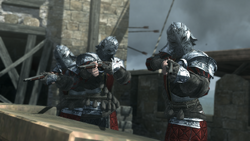
A line of arquebusiers
The Arquebusiers, also called Gunmen or Riflemen, were firearm-wielding soldiers who patrolled rooftops, protected high-value locations, and guarded important individuals.
Though Arquebusiers did not have as great a range as Crossbowmen, what they lacked in distance, they made up for in power. Their shots dealt significant damage to both targets and enemy armor. In the Renaissance, they wore heavy armor and full helmets, as well as belts of gunpowder and ammunition.[4]
Bombmen
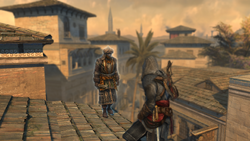
Ezio facing an Ottoman Bombman
In Constantinople, Bombmen wielded thunder bombs and short blades, and commonly guarded the rooftops in high traffic areas, such as the docks, arsenal, and harbor. They would also participate in the protection of Templar dens, and would attack from the safety of reinforced sentry boxes.
Byzantine Bombmen wore uniforms similar to Almogavars, though with longer red capes.[5]
18th century Caribbean
Snipers
- Main article: Snipers
Snipers were specially trained gunmen during the Golden Age of Piracy who were armed with muskets and would guard the rooftops. They often watched over sugar plantations, and would fire at intruders or run to an alarm bell to call reinforcements.
French Revolution
Snipers
Snipers were mainly used during the French Revolution for guarding large structures or fortresses which were occupied by Revolutionaries such as The Temple or The Palais du Luxembourg. They carried musket rifles which were deadly effective if a shot could be landed on a target. A target could be almost killed by only one shot. Snipers dressed alike and often did not appear similar to other types of Revolutionaries.
Specialized types
Certain high-ranking guards possessed unique qualities, usually granting them an advantage in combat through added speed, strength, or defensive skills. They would often act as leaders for patrols of standard guards, and possessed uncommon weapons or armor.[2]
Renaissance
Agiles
- Main article: Agile guards
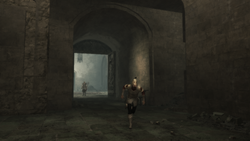
An Agile fleeing from Ezio
Agiles were lightly-armored, quick moving guards. They were one of the types capable of outrunning Assassins, and were also skilled free-runners. They more commonly fled to alert nearby guards, rather than face an enemy directly.
During pursuits alongside other guards, Agiles would usually catch up to a target first and injure them with the short blades they wielded. In battle, they were very light on their feet and could dodge nearly all attacks. Agiles wore the least armor of any guard, with only a light leather chest guard, and metal helmet and spaulders. Due to their increased vulnerability, they were also the most cowardly of the specialized types.[2]
Brutes
- Main article: Brutes
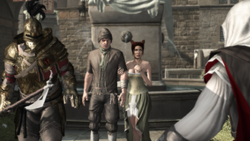
A Pazzi Brute blocking Ezio's path
Brutes were the most heavily-armored guards during the Renaissance. They moved slowly due to the two-handed weapons they wielded, but compensated through resilience and power.
They were not very vigilant, and could not normally distinguish Assassins from anyone else in a crowd. In guard patrols, they often acted as the leader, as they had the highest morale of any guard type, fleeing only if they were disarmed and could not obtain another weapon. Brutes could be easily seen from their large, reinforced armor and closed helms.[2] Brutes in Rome had more intricate armor than those in other cities, with designs worked into the metal.[4]
Seekers
- Main article: Seekers
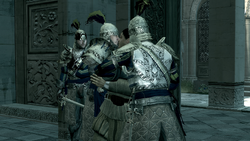
Seekers arresting a merchant
Seekers were guards who, as their name suggested, would search through hiding places, on the suspicion that an Assassin had taken refuge within one. They always wielded polearms, such as spears and halberds.
Similarly to Brutes, they would lead patrols of guards, often halting the group to search any hiding spots they passed.[2] In battle, they had the second highest morale to Brutes, and were skilled enough to resist most attacks and counters.[4] They were slightly more heavily-armored than a standard guard, though less so than Brutes, wearing a combination of chainmail and plate armor, as well as distinctive feathered helms.[2]
Horsemen
- Main article: Horsemen
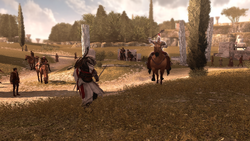
Ezio fighting a horseman
Horsemen were mounted guards that possessed the ability to use a variety of weapons while on horseback. Their steeds allowed them to easily pursue targets, and strike preemptively.
Though they were vulnerable to long-ranged weapons such as throwing knives and crossbows, they could be easily dealt with after being knocked from the saddle, either by tripping their horse, or striking them from horseback.
Horsemen were equipped with both medium and long-ranged weapons, though none could wield polearms. They were armored similarly to Borgia Captains, albeit without the cape.[4]
Almogavars
- Main article: Almogavars
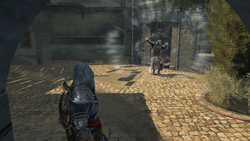
Ezio throwing a bomb at an Almogavar
Almogavars were heavily-armored Byzantine guards, who wielded two-handed axes. They were stationed in Byzantine-controlled districts of Constantinople, as well as in Derinkuyu during the Renaissance.
Comparable to Brutes, they fought with heavy weapons, and were slower than all other enemies. Due to their thick armor, they were very resilient, and could not be killed with a single bullet or crossbow bolt. However, they possessed a profound weakness to the effects of datura bombs.
They wore golden lamellar cuirasses with a Templar cross engraved into each lamella, their armour was notably decorated with fur and was topped by particularly large metal pauldrons. They also wielded unique axes, with a pair of crescent-shaped blades.[5]
Varangians
- Main article: Varangians
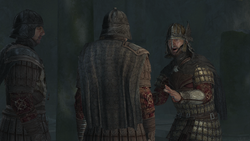
A Varangian speaking to two Militiamen
Varangians were the Byzantine equivalent of Seekers, and were stationed in both Constantinople and Derinkuyu. They were very skilled in battle, and could deflect nearly all strikes and counterattacks.
They wore the same golden lamellar as the Almogavars with short grey capes, as well as intricate winged helmets. They fought with halberds or spears, as well as short pistols.[5]
18th century Caribbean
Agiles
Similar to the Agiles of the Renaissance, these guards fought with short knives, and were capable of chasing down Assassins, both on the ground and on rooftops, and would tackle their target upon catching them. Like most guard types, they were vulnerable to a disarming attack, but they would quickly retrieve their weapons if such an attack occurred. However, it was possible to disarm them and quickly throw the knife at them, killing them.
On larger naval ships, such as frigates and Men O' War, two agiles occasionally acted as officers, and were necessary to kill in order to board the vessel.
Brutes
Often seen guarding restricted areas, brutes were large, powerfully-built men who wielded boarding axes and were capable of blocking most attacks. However, they were vulnerable to an attack that would break their defense and leave them open to a killing blow.
On smaller naval ships, such as gunboats and schooners, brutes could be seen steering the vessel, and were the most skilled fighters on board.
Captains
Although occasionally seen on land, captains were more often found on ships, commanding brigs, frigates, and Men O' War. Equipped with both a sword and pistol, captains used both weapons in combat, and could block most attacks with ease. However, successfully countering an attack from a captain would leave them open for a damaging string of blows.
Sharpshooters
Found patrolling and guarding rooftops and walkways, sharpshooters carried long-range muskets capable of hitting their target from a considerable distance; however, their rate of fire was moderately slow, and required time to reload and aim. When directly confronted by an enemy, the gunmen tended to back up and create enough space between themselves and their target to properly aim and shoot them. In close range, the sharpshooters were no more skilled than normal guards, and could be easily dispatched with a counter-attack.
Enlightenment Age
Gang Scouts
Similar to Agiles during the Renaissance and the Golden Age of Piracy, Gang Scouts fought with short knives and were able to chase down Shay Cormac on the ground and on rooftops. Similar to Brutes and Grenadiers, Scouts are able to throw bombs; specifically, smoke bombs.
Stalkers
Stalkers were gang members trained by the Assassins. They are predominantly found in gang-occupied territories. Similar to the Stalkers in the Ottoman Empire, Stalkers were dressed like normal civilians and can blend in by sitting on benches or even blend in with a group of civilians. However, they are able to hide in hiding spots such as sheds or even bushes, akin to Guardians who protected the Observatory. When they notice Shay, they will attempt to assassinate him by either running towards him or attempt to air assassinate him.
Interestingly enough, most Stalkers that Shay encounters in New York are women, in the River Valley, they are natives american and in North Atlantic, men who wear a similar uniform of spanish captains during the Golden Age of Piracy .
Gang Brutes
Grenadiers
- Main article: Grenadiers
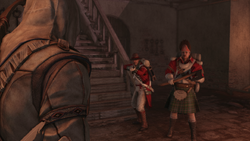
A Loyalist and a Grenadier blocking Connor's path
Grenadiers were specialized units in the British and Continental armies during the American Revolutionary War. They were roughly comparable to the Italian Brutes and Byzantine Almogavars, being slower than other soldiers, and fighting with heavy weapons and muskets.
Grenadiers were recognizable by their miter caps, which were designed not to obstruct the throwing of grenades. While the British Army's Grenadiers wore green kilts, a dress top and sapper's gloves, the Continental Grenadiers wore khaki battle dress with black boots.
Officers
- Main article: Officers
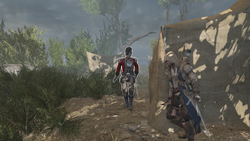
Connor hiding from an Officer
Officers in both armies led groups of other guards on patrols and were equipped with a sword and pistol. Whilst wielding their sword, they parried all of Connor's regular attacks, forcing him to either break their defense or disarm them first. They could also counter Connor's counter-kills even if disarmed, but were susceptible to throws, stuns, disarms and secondary weapon kills.
If any horses were nearby, Officers would mount them and attempt to attack Connor on horseback, either by charging or firing their pistol. Officers could see through disguises and would search hiding spots. When patrolling alone, they would be accompanied by guard dogs, who would give away Connor's location if they got close enough.
Scouts
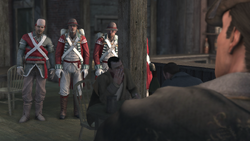
A British Scout and two Loyalists provoking Haytham Kenway
Akin to the Agiles that served throughout the Renaissance, Scouts were fast-moving adversaries capable of free-running that wielded short blades and muskets. They would pursue any attackers that fled from battle, and could not be disarmed or have their defense broken.
They were, however, susceptible to all other forms of counter-attacks. In combat, they would attempt to flip over Connor's back and attack him from behind, similar to the "hook and run" maneuver used by the Turkish Assassins.
Snitches
- Main article: Snitches
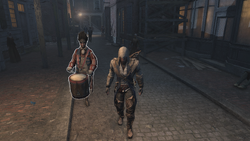
Connor passing by a Snitch
Snitches were usually seen in large guard patrols carrying military drums. They never fought with an attacker, choosing to instead flee the scene and bring reinforcements. If they could not flee, they would brandish a dagger or cower.
The British drummers were usually seen wearing ceremonial bearskin hats and red coats, whereas the Continental Army equivalent were seen wearing yellow coats and similar headgear to British drummers.
French Revolution
Brutes
Halberd Carriers
Halberd carriers were Brute type guards similar to Axe Carrier Brutes except they carried long halberd weapons which could easily take down Assassins in just a few strikes and wore large tricorne hats and long coats.
Axe Carriers
Axe carriers were more common Brute type guards. They wore striped red and black clothing combined with satin-like yellow attire and wore small satin, red hats. They carried large axes and could use deadly finishing moves on an enemy.
Expert types
Expert guards were high-ranking guards, who were the most skilled and well-equipped of their time. They often possessed several of the qualities of specialized guards, and were limited in number.[1][2]
High Middle Ages
Templar Knights
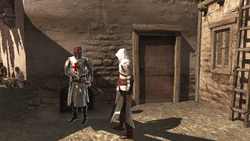
Altaïr standing next to a Templar Knight
Templar Knights were particularly skilled Crusaders, and were stationed throughout the Kingdom and its cities. They would often position themselves with a wall or cliff to their back, to prevent them from being attacked from behind.[1]
They were particularly vigilant, and could identify an Assassin from a crowd almost immediately, subsequently attacking them. Other guards held the knights in high regard, and would always stand back should the Templar Knight engage in battle with an Assassin. They were similar to the Crusader Captains, but with unique armor. They wore chainmail and white surcoats with red crosses, as well as red lacquered great helms.[1]
Renaissance
Papal Guards
- Main article: Papal Guard
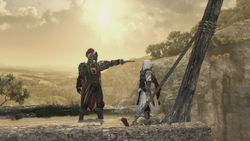
A Papal Guard holding Ezio at gunpoint
The Papal Guard were elite soldiers throughout the Renaissance and were commanded by the Papacy, to serve and protect the pontiff during his tenure. They combined the best qualities of all the other specialized guards, being very powerful in battle, as well as quick on their feet.
They wore intricate black and gold armor, as well as long dark capes, metal face masks and plumed helmets. They also wore crests painted on their chest guards, either displaying the crossed keys of the Papacy, or (in the 16th century) the red bull of the Borgia. Papal guards could use a wide variety of weapons, including long or heavy ones, though they most commonly dual-wielded a pistol alongside a medium weapon.[4]
Janissaries
- Main article: Janissaries
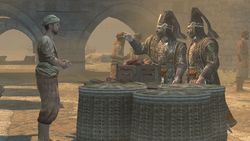
A pair of Janissaries harassing a merchant
Janissaries were highly-trained soldiers, and the elite of the Ottoman Empire, serving as the private guards to the Sultan. Similarly to the Papal Guard, they encompassed all the skills of the specialized guards.
Their uniforms consisted of colorful robes with embroidered patterns, as well as black headdresses and metal face masks. They all wielded unique kijils, as well as short pistols for long-ranged attacks.[5]
Enlightenment Age
Gang Leaders
Gang leaders were leaders of gangs that were trained by the Assassins. Similar to the stalkers, gang leaders can hide in hiding spots and even assassinate Shay if they notice him. They are also able to use smoke bombs to attempt to stun Shay when they flee.
Jägers
- Main article: Jägers
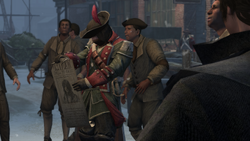
A Jäger searching for Connor
Jägers, also colloquially referred to as Hessians, were a detachment of German troops that were contracted by the British to fight in the American Revolutionary War. However, they operated independently of most British protocols.
Jägers specialized in deep forest and wilderness combat, tactics and reconnaissance, as well as unconventional warfare. As such, they were regarded as an elite scouting unit, used for surveying an area ahead of a body of troops or leading the way on the front lines.
The Jägers gained a fierce reputation as fearsome warriors and reliable, disciplined troops, and they were well respected within the ranks of the British Army. Like the other expert archetypes, Jägers combined the aspects of the basic archetypes. They patrolled in search of Connor, wielded a sword and pistol, and could fight on horseback, like Officers.
Being mainly skirmisher type troops, Jägers were rarely seen inside cities. However, due to their elite status and very honed tracking abilities, they were called into populated areas when Connor became a persistent danger to British and Patriot troops.
In combat, they were immune to direct attacks and would occasionally throw grenades, similar to the Grenadiers. While in pursuit, they could easily catch up to Connor, being one of the only archetypes to do so barring Scouts.
There were two types of Jäger located in Colonial America during the American Revolutionary War; Loyalist Jägers were found within the British Army and Patriot Jägers were found within the Continental Army.
- Loyalist Jägers wore green coats with red trim, black boots and tricorn hats with a red feather.
- Patriot Jägers wore green coats with gold trim, black boots, and Tarletons with black horse hair trim.
French Revolution
Elite Fencers/Royal Guard
Elite Fencers were the Revolutionary version of the highest ranking guard during the French Revolution. They wore attire similar to that of Militia guards and axe carrying Brutes but wore a plumed top hat in addition. The city guard version of this enemy wore blue attire combined with pieces of steel plate armor. They carried light one handed swords that were perfect for speed and precision. Both versions of this enemy were highly dangerous and could easily kill an Assassin if the Assassin was not careful. They could block every regular attack that was launched at them and would often parry some attacks. In addition to this they could easily duck under or role away from gun shots. They could also easily catch up to Arno during a chase and could try to shoot him from behind to slow his pace. However, this enemy type could easily be killed if they were worn out by an Assassin or their defense was broken.They could easily knock down Arno in combat and push him away. When they parried Arno's attack they could could easily counter and kill him.
Trivia
- The taunts Ezio said to Brutes were different from those he said to the other guards, mainly insulting them about their weight, as they were bulkier in stature.
- In the memory "Clothes Make the Man," Ugo told Ezio that the thieves were to impersonate the archers. Yet in the next memory, "Everything Must Go", after Ezio killed the archers on the rooftops, the thieves wore the armor of captain guards instead of archer armor.
- In the memory "Infrequent Flier", a Brute and a Seeker could be seen stationed on a rooftop, despite being the only guards who could not climb or free-run.
- In the memory "Play Along", Ezio assassinated an Agile so he could disguise himself as a guard, but instead of having an Agile's outfit, he wore the outfit of a Leader guard.
- Several other guard types were present only in Assassin's Creed: Bloodlines and Assassin's Creed: Altaïr's Chronicles, such as Shield Guards, Duelists, and Moloch's zealots.
- In the memory "French Kiss", Ezio killed twenty French guards of different archetypes to acquire their armor. However, in the following memories, Bartolomeo's mercenaries were equipped with only Leader armor, while Ezio wore armor similar to a Borgia Captain's.
- Additionally, though Ezio's Captain armor during the memory was in French colors, no such French guard could ever be encountered.
- In Assassin's Creed: Brotherhood and Assassin's Creed: Revelations, an extremely rare glitch could occur with a group of four guards. They would stand still and would not pay any attention to Ezio, even if he killed someone nearby. He was still free to attack them, in which case an execution would be performed, but it would not kill them, leaving them to simply stand up again.
- On PlayStation Home, the design of a Seeker can be purchased for an avatar. Similarly, on Xbox Live, it is possible to purchase the outfit of an Agile guard.
- In Assassin's Creed: Brotherhood, even after the completion of Sequence 8 and the liberation of all Borgia Towers, all of the guards in Rome would still wear the colors of the Borgia family as well as their coat of arms.
- In Assassin's Creed: Unity, rooftop guards have been removed except in certain missions.
References

- ↑ 1.0 1.1 1.2 1.3 1.4 1.5 1.6 1.7 1.8 1.9 Assassin's Creed
- ↑ 2.00 2.01 2.02 2.03 2.04 2.05 2.06 2.07 2.08 2.09 2.10 2.11 2.12 2.13 Assassin's Creed II
- ↑ Assassin's Creed II - Bonfire of the Vanities (DLC)
- ↑ 4.0 4.1 4.2 4.3 4.4 4.5 4.6 4.7 4.8 Assassin's Creed: Brotherhood
- ↑ 5.0 5.1 5.2 5.3 5.4 Assassin's Creed: Revelations
- ↑ Assassin's Creed IV: Black Flag
- ↑ Assassin's Creed: Unity
- ↑ Assassin's Creed: Project Legacy
| ||||||||||||||||||||||||||||
| |||||||||||||||||||||||||||||||||||||
